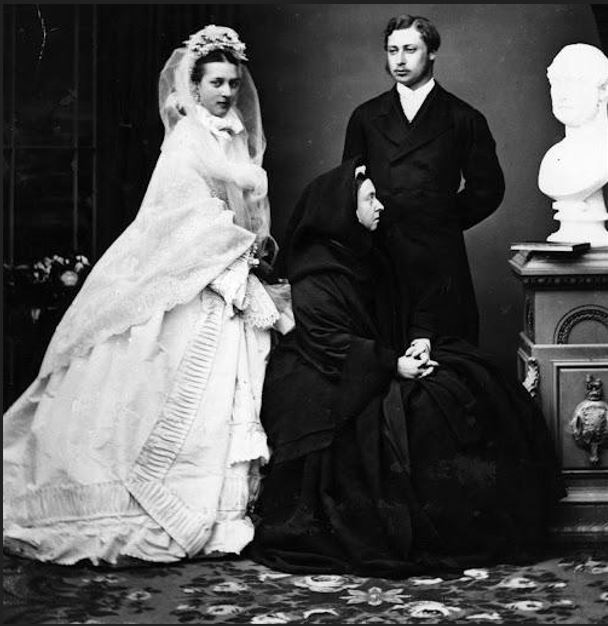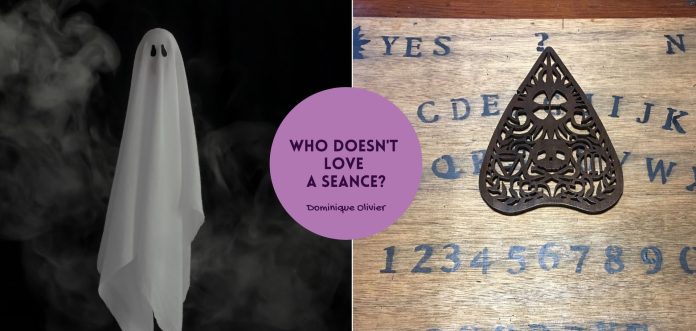AI is threatening to resurrect the dead, using the footprints we leave behind online for reference. The Victorians did the same thing, just with less tech.
For Kim Kardashian’s fortieth birthday (way back in 2020), her then-husband Kanye West presented her with an unexpected and deeply surreal gift: a hologram of her late father, Robert Kardashian. According to reports, Kim was overcome with a mix of disbelief and joy as she watched her father, long gone, appear virtually at her birthday celebration, speaking and moving as if he was really in the room.
The idea of reconnecting with a loved one who has passed on, even through technology, might seem like a miracle – or something straight out of a Black Mirror episode. Because let’s be honest: as comforting as it might sound, the concept of resurrecting the dead via deepfake technology treads a fine line between heartwarming and profoundly unsettling. The realistic output of this cutting-edge AI software comes from the fact that it uses data like photographs, videos, and emails to construct an eerily lifelike virtual representation of the deceased. Think of it as a digital echo crafted from the fragments they left behind.
What once seemed like the fever dream of science fiction writers is strongly on its way to becoming our reality. Of course, this isn’t the first time that we’ve received personal messages from beyond the grave.
Ghost fever
The Victorians (those living during the 63 years of Queen Victoria’s reign over Great Britain and Ireland, from 1837 to 1901) had an almost obsessive fascination with the dead.
Queen Victoria herself may have been part of the reason for this. Her grief for her late husband, Prince Albert, was nothing short of monumental – a mourning ritual so elaborate and enduring it shaped not just her life but the culture of an entire era. For 40 years after Albert’s death (and the majority of her rule), the queen dressed exclusively in black, a living emblem of perpetual widowhood, and insisted that their home remain frozen in time, exactly as it had been the day he died.
Each morning, servants dutifully performed the rituals of a man who was no longer there. Albert’s clothes were carefully laid out, hot water was brought for his shaving cup, and even his chamber pot was scoured as though he might return at any moment. The bed linens were changed daily, and by his bedside, the glass from which he took his final dose of medicine remained untouched.
Victoria’s devotion extended beyond these daily rituals. In every official photographic portrait of the royal family, a bust or painting of Albert was included, often positioned prominently among the children and other relatives posing for the camera. It was as if, even in death, he was still the head of the household, his presence woven into the very fabric of the family’s identity. Consider the below photo, taken on the occasion of her son’s wedding, with the queen wedged solidly between the newlyweds but turned away from the camera, instead facing a bust of her late husband. The bride must have been thrilled.

This intense display of mourning by the head of the nation, combined with the high mortality rates in Victorian England, created a culture where thinking about death and the departed was as normal as thinking about what’s for dinner. The bereaved found comfort in the notion that those who were lost to them weren’t gone, simply on a different plain, where they could potentially still be reached. This interest found its most theatrical expression in the spiritualist movement of the 19th century. At its core was the idea of communicating with those who had passed on, often facilitated by mediums claiming to bridge the gap between the living and the beyond.
Hello from the other side
In no time at all, public displays of mediumship and psychic power became all the rage, particularly among the upper classes. Seances, in particular, became the centrepiece of many a wealthy host’s evening entertainment. Gathered in elaborately decorated parlour rooms, guests would sit in tense anticipation as mediums conjured spirits – or at least the appearance of them – through dramatic table rapping, ghostly apparitions, or messages from the other side. These events combined the thrill of the supernatural with the flair of a theatrical performance, satisfying both a cultural curiosity and a hunger for spectacle.
Of course, not everyone was convinced. While some swore by the authenticity of these paranormal encounters, sceptics accused mediums of being charlatans, exploiting grief for profit. Yet even these accusations didn’t dull the fascination. Whether out of belief, curiosity, or a desire to impress their social circle, Victorians flocked to seances and other displays.
Among them was none other than Sir Arthur Conan Doyle, the famed creator of Sherlock Holmes. In the 1880s, a young Arthur Conan Doyle – then a doctor living in England – found himself drawn to the shadowy allure of the spiritualist movement. He became a regular attendee and host of seances, where he observed uncanny displays of psychic phenomena such as telepathy, automatic writing, and the eerie spectacle of table tipping. These experiences convinced him that there was more to existence than the physical world, leading the lapsed Catholic to declare himself a Spiritualist.
The horrors of World War I and the devastating losses it brought to his family forever altered Doyle’s spiritual path. In 1918, his eldest son, Kingsley, succumbed to complications from pneumonia, a casualty of both war wounds and the influenza pandemic. The following year, Doyle lost his brother, and soon after, two of his nephews. These successive blows left him bereft, but also searching, and he turned to Spiritualism with renewed passion.
For Doyle, the unseen world wasn’t just a possibility; it was a certainty, one he dedicated his later years to exploring and sharing with others. So intense was Doyle’s belief in a life after this one that he planned to deliver a message at his own memorial service.
On July 13, 1930, some six thousand people crammed themselves into London’s Royal Albert Hall to hear Sir Arthur Conan Doyle speak, six days after his death. Among the chairs set on stage for the Conan Doyle family – Lady Conan Doyle, her children Denis, Adrian, Jean, and stepdaughter Mary – there was one more, marked with Sir Arthur’s name.
The service began traditionally, with hymns, scripture readings, and tributes. But the atmosphere shifted when Estelle Roberts, a prominent London medium and one of Conan Doyle’s favourites, took the stage. For about half an hour, she attempted to commune with various spirits, though the restless audience began to thin. Then, as some started leaving, Roberts suddenly exclaimed, “He’s here!”
She later told reporters that she had seen the spirit of Conan Doyle himself stride across the stage and sit in the reserved chair, before getting up to deliver a whispered message in her ear. That message was then whispered into the ear of the widow Conan Doyle by the medium, who smiled and nodded upon hearing it. Lady Conan Doyle was resolute in her belief. “I am perfectly convinced the message is from my husband,” she declared. “I am as sure he was here with us as I am sure I am speaking to you. It was a happy message – cheering, encouraging, and sacred. It is precious to me and will remain secret.”
We’ll never know what the message was, because Lady Conan Doyle indeed kept it a closely guarded secret until her own death in 1940 – and by that time, interest in mediums had waned enough that no-one was volunteering to ask her to disclose it from beyond the veil.
Ghosts in the machine
The parallels between Victorian spiritualism and today’s AI-driven resurrections are striking. At their core, they reveal a persistent human longing to connect with those we’ve lost. Where Victorian mediums harnessed theatrical flair to channel the departed, today’s technology uses algorithms to recreate their voices and likenesses, offering a digital substitute for the closure we seek. In both cases, the emotional appeal is undeniable, yet it walks a precarious line between solace and exploitation.
The question lingers: at what point does this act of remembrance become a tool for profit, manipulation, or even self-deception? Whether through the smoke and mirrors of a seance or the uncanny accuracy of a hologram, both mediums and machines remind us of the same truth: grief can make us vulnerable, and the promise of connection, however fleeting or fabricated, is an offer many are willing to accept at any price.
About the author: Dominique Olivier

Dominique Olivier is the founder of human.writer, where she uses her love of storytelling and ideation to help brands solve problems.
She is a weekly columnist in Ghost Mail and collaborates with The Finance Ghost on Ghost Mail Weekender, a Sunday publication designed to help you be more interesting.
Dominique can be reached on LinkedIn here.





Excellent article. Thankyou. As someone who lost his beloved wife 5 years ago and thinks of her and misses her every day, I find all this stuff incredibly creepy. I suspect most of it (then and now) has a profit motive, making money off the sad and grief-stricken. But then, money is made off everything else so why think this should be any different. The mediums mostly used “magic tricks” and crockery to fool their customers. Isnt that what AI is?